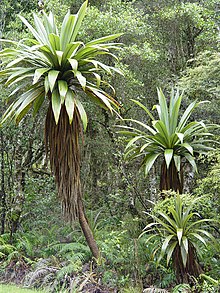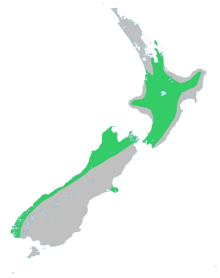TI, ti, and variants may refer to:

Cordyline australis, commonly known as the cabbage tree, or by its Māori name of tī or tī kōuka, is a widely branched monocot tree endemic to New Zealand.
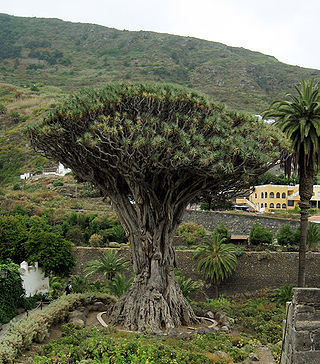
Dracaena is a genus of about 120 species of trees and succulent shrubs. The formerly accepted genera Pleomele and Sansevieria are now included in Dracaena. In the APG IV classification system, it is placed in the family Asparagaceae, subfamily Nolinoideae. It has also formerly been separated into the family Dracaenaceae or placed in the Agavaceae.

Aristotelia serrata, commonly known as wineberry or in the Māori language makomako or just mako, is a small tree in the family Elaeocarpaceae, in the genus Aristotelia, found in the North Island, South Island and Stewart Island of New Zealand. It is a small deciduous fast-growing tree or shrub. The tree can reach up to 10m tall, with a trunk diameter up to 30 cm. The bark is pale brown, smooth and patterned with flat lenticels. Branches are long, slender and spreading, branchlets have a reddish-brown colour when pubescent.

Cordyline fruticosa is an evergreen flowering plant in the family Asparagaceae. The plant is of great cultural importance to the traditional animistic religions of Austronesian and Papuan peoples of the Pacific Islands, New Zealand, Island Southeast Asia, and Papua New Guinea. It is also cultivated for food, traditional medicine, and as an ornamental for its variously colored leaves. It is identified by a wide variety of common names, including ti plant, palm lily, cabbage palm.

Cordyline is a genus of about 24 species of woody monocotyledonous flowering plants in family Asparagaceae, subfamily Lomandroideae. The subfamily has previously been treated as a separate family Laxmanniaceae, or Lomandraceae. Other authors have placed the genus in the Agavaceae. Cordyline is native to the western Pacific Ocean region, from New Zealand, eastern Australia, southeastern Asia and Polynesia, with one species found in southeastern South America.
Cabbage tree is a common name for several plant species:
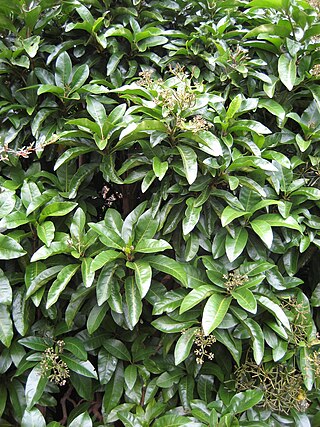
Pisonia brunoniana is a species of flowering tree in the family Nyctaginaceae that is native to New Zealand, Norfolk Island, Lord Howe Island and Hawaiʻi. The common names in New Zealand are parapara or birdcatcher tree.
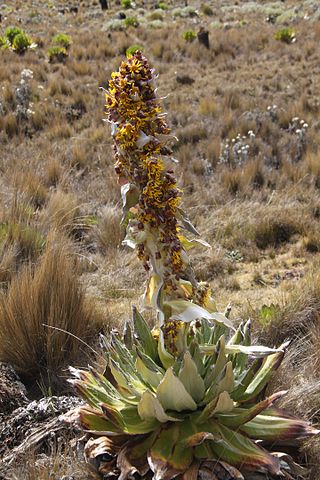
Dendrosenecio keniensis is one of the giant groundsels endemic the higher altitudes of Mount Kenya. It is in the family Asteraceae and the genus Dendrosenecio. Dendrosenecio keniodendron occurs the upper alpine zone of Mount Kenya and D. keniensis in the wetter areas of the lower alpine or the moorlands.

Ixerba brexioides, the sole species in the genus Ixerba, is a bushy tree with thick, narrow, serrated, dark green leaves and panicles of white flowers with a green heart. The fruit is a green capsule that splits open to reveal the black seeds partly covered with a fleshy scarlet aril against the white inside of the fruit. Ixerba is an endemic of the northern half of the North Island of New Zealand. Common names used in New Zealand are tawari for the tree and whakou when in flower. It is assigned to the family Strasburgeriaceae.

Cordyline obtecta is a widely branching monocot tree native to Norfolk Island, and to northern New Zealand. The species name obtecta derives from the Latin obtegere, alluding to the way the inflorescence barely protruded beyond the leaves in the plant first described.

The North Island robin is a species of Australasian robin endemic to the North Island of New Zealand. It and the South Island robin of the South Island and Stewart Island were once considered conspecific, but mitochondrial DNA sequences have shown that the two lineages split prior to the Pleistocene, and support the classification as two different species.

Dracaena fragrans, is a flowering plant species that is native throughout tropical Africa, from Sudan south to Mozambique, west to Côte d'Ivoire and southwest to Angola, growing in upland regions at 600–2,250 m (1,970–7,380 ft) altitude. It is also known as striped dracaena, compact dracaena, and corn plant.
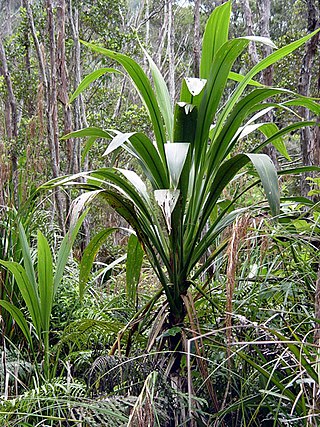
Cordyline banksii is a monocot tree endemic to New Zealand. The specific epithet banksii refers to the 18th-century botanist Joseph Banks.

Scolypopa australis, commonly known as the passionvine hopper, is a species of insect in the Ricaniidae family of planthoppers (Fulgoroidea) that is native to Australia and was introduced to New Zealand. Despite its name, they are found not only on passion vines, but on many plant species, including kiwifruit and the lantana. Brown with partly transparent wings, they are 5–6 mm long as adults and 5 mm as nymphs. As an adult they look somewhat like a moth to the untrained eye, and walk "like a ballerina". The nymphs are wingless and are informally known as fluffy bums. When sufficiently aroused they will hop off their plant "with a 'snap'". Like all planthoppers they suck plant sap. This leaves a honeydew secretion which bees gather.

Cordyline pumilio, commonly known as the dwarf cabbage tree, pygmy cabbage tree or by its Māori names tī koraha or tī rauriki, is a narrow-leaved monocot shrub endemic to New Zealand. It usually grows up to 1 metre tall, although rare examples of 2 metres tall have been reported. It has long leaves and can easily be mistaken for a grass or a sedge. C. pumilio grows in the north of the North Island from North Cape at 34°S to Kawhia and Opotiki at about 38°S, generally under light forest and scrub. It was cultivated by Māori as a source of carbohydrate and used as a relish to sweeten less palatable foods.
Balanococcus cordylinidis, the cabbage tree mealybug, is a species of insect in the family Pseudococcidae.

Dracophyllum arboreum, commonly known as Chatham Island grass tree and tarahinau (Moriori), is a species of tree in the heath family Ericaceae. Endemic to the Chatham Islands of New Zealand, it reaches a height of 18 m (60 ft) and has leaves that differ between the juvenile and adult forms.
